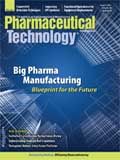Offshoring Biomanufacturing
China rises to the top as a destination for international outsourcing.
Trends in Asia biomanufacturing stood out this year in BioPlan Associates' 8th Annual Report and Survey of Biopharmaceutical Manufacturing Capacity and Production (1). The study asked respondents to consider their five-year time horizon to 2015 and evaluate their facility's current plans for international (i.e., nondomestic) capacity expansion. For the first time, China ranked highest in the world with 17% of respondents identifying the country as a potential biomanufacturing outsourcing destination. India was the choice of 13.2% of respondents, and Singapore was selected by 9.5% of respondents. The United States was chosen by 15.1% of respondents (see Figure 1). The results show that the demand for biomanufacturing capacity in Asia in serving regional or domestic markets can outweigh managerial concerns when offshoring manufacturing. This year's survey had responses from 352 global biomanufacturers and covered issues associated with production bottlenecks, budget trends, use of disposables, downstream production, and quality management (1).

Eric Langer
These findings support the continuing rise of Asia as a global biomanufacturing power. In coming years, many biopharmaceuticals originally launched in Western markets in the 1980s and 1990s, including many blockbusters, will be coming off patent. Multiple biosimilar and bio-better versions are likely to be marketed for each product, thereby resulting in a significant expansion of companies developing and manufacturing biopharmaceuticals. Although the great majority of biopharmaceutical manufacturing and consumption in emerging markets currently involves biogenerics or other copies of products developed by Western innovator companies, these foreign markets, although still relatively small, are growing at a more rapid pace than major Western markets.

Figure 1: Destination for international outsourcing of biomanufacturing. (FIGURES 1 AND 2 ARE COURTESY OF THE AUTHOR)
Inside the numbers
According to BioPlan's recently released Top 1000 Global Biopharmaceutical Manufacturing Index, China holds 8.5% of the global concentration of capacity and employment, India 8.0%, and Japan and other Asian countries 9.2%; these areas are growing more rapidly in biomanufacturing capacity than the global average. Asia-Pacific has one of the largest concentration of global biopharmaceutical manufacturing capacity (2). Asia's combined share of 25.7% of global concentration of capacity and employment virtually matches Europe's share at 26.2% and is gaining on North America's share of 37.5%. These results show that the biopharmaceutical industry is becoming increasingly international in scope and is beginning to move away from its exclusively US and European focus as larger manufacturers locate in emerging markets to support regional markets and provide backup manufacturing for products in major markets. The BioPlan study suggests that biopharmaceutical research and development, both for biosimilars and innovative products, is increasing in China, India, Russia, and select emerging markets (2).
Also, many large Chinese and Indian companies are developing commercial-scale biopharmaceutical manufacturing facilities to serve domestic and regional needs. This trend is evident in vaccine manufacturing. An important development occurred earlier this year in March, when the World Health Organization (WHO) reported that China's State Food and Drug Administration was shown to comply with international standards for vaccine regulation. With a regulatory system for vaccines documented to comply with international standards, vaccine manufacturers in China are now eligible to apply for WHO prequalification of specific products. Prequalification, which is a guarantee that a specific vaccine meets international standards of quality, safety, and efficacy, is a prerequisite for manufacturers to supply to countries through UN procuring agencies (3).
Other effects
Along with biopharmaceutical manufacturing growth in Asia comes opportunity for vendors, such as providers of equipment and consumables. The BioPlan study shows that more than half of respondents specifically sell to India and China, and 38.7% of all vendors sell in other Asian markets (2).
The growth of emerging countries also contribute to a tightening of the global scientific labor markets. This year's survey showed that concerns over hiring are increasing as the global economic downturn stabilizes. Expectations of constraints due to the "inability to hire new, experienced scientific staff" jumped from 19.1% of respondents in 2010 to 27.6% in 2011. The survey, which compiled the factors likely to create biopharmaceutical production constraints by 2015, found that facility constraints (48.6%) topped the list, followed by the "inability to hire new, experienced technical and production staff" (31%) and the "physical capacity of downstream purification equipment" (28.1%) (see Figure 2). This tightening for experienced bioprocessing specialists may be due to expansions in growth of operations and further exacerbated by specialists increasingly spread out over a growing number of biopharmaceutical companies worldwide.

Figure 2: Select factors creating future capacity constraints.
Eric Langer is president of BioPlan Associates, tel. 301.921.5979, elanger@bioplanassociates.com, and a periodic contributor to Outsourcing Outlook.
References
1. BioPlan Associates, 8th Annual Report and Survey of Biopharmaceutical Manufacturing Capacity and Production: A Survey of Biotherapeutic Developers and Contract Manufacturing Organizations (Rockville, MD), April 2011.
2. BioPlan Associates, Top 1000 Global Biopharmaceutical Facilities Index, www.top1000bio.com/index.asp, accessed June 20, 2011.
3. WHO, "China's State Food and Drug Administration Gets WHO Approval for Vaccine Regulatory System" Press Release, Mar. 1, 2011.

Pharmaceutical Tariffs Are Imminent: How Industry is Bracing for Impact
April 16th 2025On April 14, 2025, the Trump Administration launched a national security-driven investigation into pharmaceuticals, a move that will likely result in tariffs being placed on pharmaceutical drugs, ingredients, and other components that are imported from outside of the United States.
Drug Solutions Podcast: A Closer Look at mRNA in Oncology and Vaccines
April 30th 2024In this episode fo the Drug Solutions Podcast, etherna’s vice-president of Technology and Innovation, Stefaan De Koker, discusses the merits and challenges of using mRNA as the foundation for therapeutics in oncology as well as for vaccines.